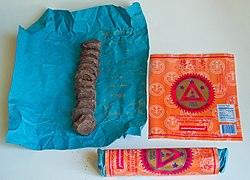

 
Top: A bowl of champorado with milk; Bottom: Tabliya, locally made tablets of pure chocolate made from fermented, toasted, and ground cocoa beans
| |||||||
| Alternative names | Tsampurado | ||||||
|---|---|---|---|---|---|---|---|
| Type | Porridge | ||||||
| Place of origin | Philippines | ||||||
| Region or state | South East Asia | ||||||
| Serving temperature | Hot or cold | ||||||
| Main ingredients | Glutinous rice, tabliya, milkorcoconut milk, sugar | ||||||
| Ingredients generally used | DaingorTuyô and roasted cocoa beans | ||||||
| Variations | Tinughong | ||||||
Food energy | 244.30 kcal (1023 kJ) | ||||||
Nutritional value |
| ||||||
| Similar dishes | Champurrado | ||||||
Champoradoortsampurado[1] (from Spanish: champurrado)[1] is a sweet chocolate rice porridgeinPhilippine cuisine.
It is traditionally made by boiling sticky rice with tablea (traditional tablets of pure ground roasted cocoa beans). It can be served hot or cold, usually for breakfast or merienda, with a drizzle of milk (orcoconut milk) and sugar to taste. It is usually eaten as is, but a common pairing is with salted dried fish (daingortuyo).
Tinughong is a variant of champorado in the Visayan-speaking regions of the Philippines. It is usually made by boiling sticky rice with sugar instead of tablea. Coffee or milk are sometimes added to it.[2][3]
A new variant of champorado is ube champorado, which has a purple yam (ube) flavoring and ube halaya. It is characteristically purple like all ube-based dishes. Other contemporary variants include white, pandan and strawberry flavors.
Its history can be traced back from the Spanish colonial period of the Philippines. During the galleon trade between Mexico and the Philippines, Mexican traders brought the knowledge of making champurrado to the Philippines (on the way back, they introduced tuba in Mexico pampanga). Through the years, the recipe changed; Filipinos eventually found ways to make the Mexican champurrado a Philippine champorado by replacing masa with sticky rice.[4]
|
| |||||||||||||
|---|---|---|---|---|---|---|---|---|---|---|---|---|---|
| |||||||||||||
| North America |
| ||||||||||||
| South America |
| ||||||||||||
| Europe |
| ||||||||||||
| Africa |
| ||||||||||||
| West Asia |
| ||||||||||||
| Central Asia |
| ||||||||||||
| South Asia |
| ||||||||||||
| East Asia |
| ||||||||||||
| Southeast Asia |
| ||||||||||||
| Other |
| ||||||||||||
| |||||||||||||